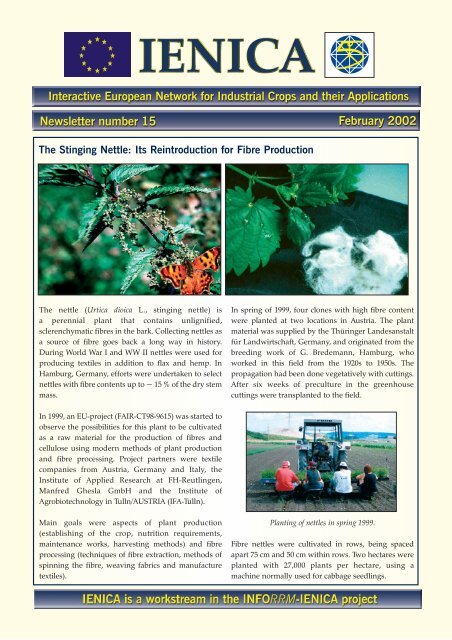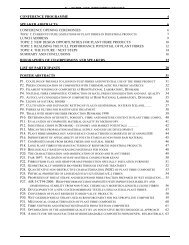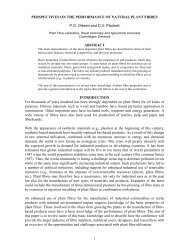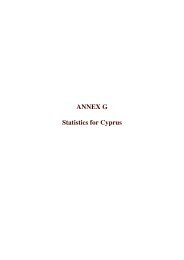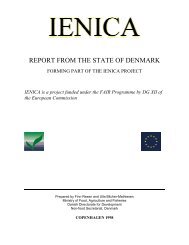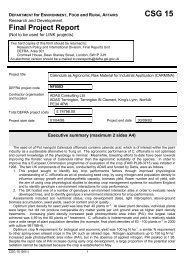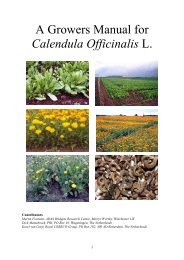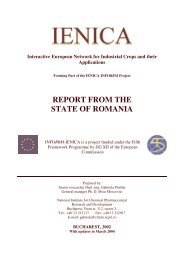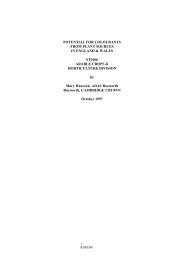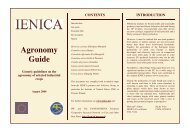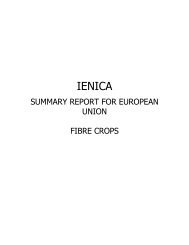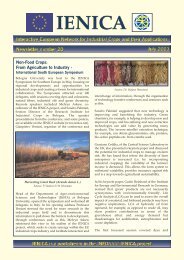The Stinging Nettle: Its Reintroduction for Fibre Production - Ienica.net
The Stinging Nettle: Its Reintroduction for Fibre Production - Ienica.net
The Stinging Nettle: Its Reintroduction for Fibre Production - Ienica.net
Create successful ePaper yourself
Turn your PDF publications into a flip-book with our unique Google optimized e-Paper software.
<strong>The</strong> <strong>Stinging</strong> <strong>Nettle</strong>: <strong>Its</strong> <strong>Reintroduction</strong> <strong>for</strong> <strong>Fibre</strong> <strong>Production</strong><br />
<strong>The</strong> <strong>net</strong>tle (Urtica dioica L., stinging <strong>net</strong>tle) is<br />
a perennial plant that contains unlignified,<br />
sclerenchymatic fibres in the bark. Collecting <strong>net</strong>tles as<br />
a source of fibre goes back a long way in history.<br />
During World War I and WW II <strong>net</strong>tles were used <strong>for</strong><br />
producing textiles in addition to flax and hemp. In<br />
Hamburg, Germany, ef<strong>for</strong>ts were undertaken to select<br />
<strong>net</strong>tles with fibre contents up to ~ 15 % of the dry stem<br />
mass.<br />
In 1999, an EU-project (FAIR-CT98-9615) was started to<br />
observe the possibilities <strong>for</strong> this plant to be cultivated<br />
as a raw material <strong>for</strong> the production of fibres and<br />
cellulose using modern methods of plant production<br />
and fibre processing. Project partners were textile<br />
companies from Austria, Germany and Italy, the<br />
Institute of Applied Research at FH-Reutlingen,<br />
Manfred Ghesla GmbH and the Institute of<br />
Agrobiotechnology in Tulln/AUSTRIA (IFA-Tulln).<br />
Main goals were aspects of plant production<br />
(establishing of the crop, nutrition requirements,<br />
maintenance works, harvesting methods) and fibre<br />
processing (techniques of fibre extraction, methods of<br />
spinning the fibre, weaving fabrics and manufacture<br />
textiles).<br />
In spring of 1999, four clones with high fibre content<br />
were planted at two locations in Austria. <strong>The</strong> plant<br />
material was supplied by the Thüringer Landesanstalt<br />
für Landwirtschaft, Germany, and originated from the<br />
breeding work of G. Bredemann, Hamburg, who<br />
worked in this field from the 1920s to 1950s. <strong>The</strong><br />
propagation had been done vegetatively with cuttings.<br />
After six weeks of preculture in the greenhouse<br />
cuttings were transplanted to the field.<br />
Planting of <strong>net</strong>tles in spring 1999.<br />
<strong>Fibre</strong> <strong>net</strong>tles were cultivated in rows, being spaced<br />
apart 75 cm and 50 cm within rows. Two hectares were<br />
planted with 27,000 plants per hectare, using a<br />
machine normally used <strong>for</strong> cabbage seedlings.
As the <strong>net</strong>tle is a nitrophyllic plant, the effect of<br />
increased amounts of nitrogen on quantity and quality<br />
of fibre yield was investigated under different levels of<br />
nitrogen using organic fertilizers.<br />
<strong>The</strong> first harvest was in 2000 because in the first year<br />
the growth per<strong>for</strong>mance was poor. In summer 2000,<br />
different cutting times and techniques of harvesting<br />
were tested. After accurate investigations of fibre<br />
quality at the Institute <strong>for</strong> Applied Research of<br />
FH-Reutlingen, Germany, the harvest time in 2001 was<br />
in the middle of August when a large amount of leaves<br />
had already fallen, but new sprouts had not yet been<br />
<strong>for</strong>med.<br />
Harvest time in August 2001.<br />
In literature, <strong>net</strong>tles are often described as being highly<br />
competitive with weeds. It is also mentioned that they<br />
need sufficient moisture and good soil conditions to<br />
produce high yields. It was observed that on the best<br />
plots the <strong>net</strong>tle plants developed well with a large<br />
amount of tall stems. In this region the plants reached<br />
up to 180 cm height and yields of almost 5 kg total fresh<br />
mass per m² were observed. As the proportion of dry<br />
stem mass is about 20 % this will be the equivalent to<br />
1 kg dry stem mass per m². Un<strong>for</strong>tunately, due to a very<br />
variable soil, the average yield was only 0,34 kg dry stem<br />
mass per m², thus 3,4 tonnes per hectare.<br />
On the worst trial areas, where soil conditions were not<br />
optimized, a lot of weeds like thistles, wild teasels<br />
and dandelion (Taraxacum officinale) suppressed the<br />
development of the <strong>net</strong>tles. As a result, the yields in<br />
these areas were only about 0,1 kg dry stem mass per m².<br />
Concerning yields, a high variability was also found<br />
between the clones as a result of different height,<br />
number of stems/plant and diameter of stems.<br />
<strong>Nettle</strong>s are described as resistant to diseases and pests.<br />
In the 2 nd year, one clone was infected by mildew.<br />
Aphids and larvae of some butterflies appeared, but<br />
not at significant levels.<br />
After harvest, the dry stems were decorticated by a flax<br />
company in Austria and the fibres sent to Germany<br />
where our partners are still busy spinning experimental<br />
yarns.<br />
Peter Ruckenbauer, Hermann Bürstmayr, Anita Stürtz<br />
Institute of Agrobiotechnology (IFA-Tulln),<br />
Tulln, Austria<br />
Tel: + 43 2272 66 280-205<br />
Email: pruck@ifa-tulln.ac.at; buerst@ifa-tulln.ac.at<br />
Professor Ruckenbauer is national coordinator <strong>for</strong><br />
IENICA in Austria<br />
BASAN<br />
Basan (Baltic Sea agro-industrial <strong>net</strong>work) is an EU<br />
financed <strong>net</strong>work with 11 participants representing the<br />
countries (apart from Russia) around the Baltic Sea.<br />
Four of these 11 participants are regional research<br />
organisations. <strong>The</strong> others are regional innovation<br />
centres. <strong>The</strong> Secretariat is based at the Bioraf Denmark<br />
Foundation situated on Bornholm, a small island in<br />
the middle of the Baltic Sea. Bornholm has 50,000<br />
inhabitants and is faced with the same challenges and<br />
problems as the other regions.<br />
Basan’s main objective is to encourage the<br />
establishment of new commercial activities based on<br />
local raw materials in the rural areas around the Baltic<br />
sea.<br />
<strong>The</strong> Baltic Sea area<br />
<strong>The</strong> Baltic Sea Area (BSA) includes 9 countries and<br />
7 relatively large islands. <strong>The</strong> entire BSA with a total<br />
of 60 million inhabitants has a history of close<br />
co-operation over many centuries.<br />
Although the regions differ in many ways, they still<br />
share many challenges and problems:<br />
Agriculture plays a dominant role<br />
Some of the Baltic Sea countries are members of the<br />
EU, and thus subject to the EU Common<br />
Agricultural Policy, and the others will most likely<br />
join in a <strong>for</strong>eseeable future.<br />
<strong>The</strong> majority of the sub-regions are considered<br />
“rand zones” (less favoured regions).
<strong>The</strong>y are faced with depopulation problems (social<br />
desertification) and /or high unemployment rates<br />
<strong>The</strong>y are relatively near important markets (big<br />
cities)<br />
<strong>The</strong> sub-regions in the BSA, where traditional<br />
agriculture is a dominating income source, will not be<br />
able to effectively counteract the depopulation and the<br />
high unemployment rates unless new activities are<br />
found, preferably industrial activities based on local<br />
raw materials, i.e. agricultural products.<br />
Experience has shown that it is very difficult to attract<br />
high tech companies and larger agro-industries to<br />
these areas. Currently a major part of the agricultural<br />
products from the regions is not processed locally, but<br />
sent to large central processing plants in urban areas.<br />
This means that the added value is created elsewhere<br />
and not returned to the local regions.<br />
However, with today’s fast developing modern<br />
technology it is possible to establish economically<br />
viable and very efficient small-scale production units.<br />
Such units should have a size that makes it feasible to<br />
place them in the areas where the raw material is<br />
produced. This is today possible due to modern<br />
computer technology, sophisticated regulation and<br />
control equipment and modern material technology.<br />
<strong>The</strong>re will be many advantages to establishing<br />
small-scale production units in the rural areas. <strong>The</strong><br />
logistics are simplified, the transportation costs <strong>for</strong> the<br />
often bulky raw materials are reduced, and, perhaps<br />
most important, it will be possible to introduce whole<br />
chain control systems. For a number of identical units it<br />
will be possible to share costs like extension service<br />
costs, costs <strong>for</strong> quality control (centralised control<br />
functions), sharing of marketing activities etc. New<br />
activities will also be created in affiliated fields such as<br />
the transport sector, the maintenance sector, energy<br />
suppliers, service suppliers, marketing functions etc.<br />
We believe that authenticity may become an important<br />
marketing parameter in the future. Already now an<br />
increasing number of consumers wish to know where<br />
the products they buy come from and how they<br />
are made. Such a demand could be met by the<br />
establishment of a <strong>net</strong>work of production units with<br />
centralised marketing and quality control. <strong>The</strong> famous<br />
“appellation controlle” system that has been applied <strong>for</strong><br />
French wine <strong>for</strong> many years may be copied <strong>for</strong> use<br />
in the Baltic Sea region <strong>for</strong> both food and non-food<br />
products.<br />
<strong>The</strong> role of the Basan <strong>net</strong>work is to encourage such a<br />
development, to define new business opportunities<br />
and to initiate transfer of know how, e.g. established<br />
within the Commission research programmes, to the<br />
individual regions in the Baltic Sea.<br />
Basan activities<br />
Basan will focus on three main issues:<br />
In<strong>for</strong>mation exchange<br />
In<strong>for</strong>mation exchanges between the involved<br />
institutions and regional authorities and entrepreneurs<br />
in order to create a “critical knowledge mass”<br />
concerning all relevant elements in the innovation<br />
chain is an important part of the work.<br />
<strong>The</strong> work involves the exchange of in<strong>for</strong>mation<br />
concerning local conditions, primarily potential<br />
markets and the presence/absence of local “success<br />
indicators” such as reasonable market size,<br />
infrastructure, recruitment possibilities, state of public<br />
services, presence of communication facilities, access to<br />
knowledge, access to structural aids etc. <strong>The</strong> relative<br />
importance of these factors will be evaluated.<br />
Besides common exchange of in<strong>for</strong>mation and<br />
presentation of “good practise” the <strong>net</strong>work will<br />
exchange views on issues such as intellectual property<br />
rights, barriers/incentives and how to attract<br />
investment capital.<br />
A web-site open to public with in<strong>for</strong>mation on contact<br />
points, the involved institutions and the ongoing work<br />
is being established. Furthermore will be established an<br />
electronic communication infrastructure in order to<br />
achieve efficient and easy in<strong>for</strong>mation flow between<br />
the participants.<br />
Identification of local barriers and constraints<br />
In order to make the work as realistic and fact oriented<br />
as possible two virtual factories will be designed.<br />
<strong>The</strong>se units will play a key role in the identification of<br />
institutional, demographic, logistic and technical<br />
barriers and opportunities in the involved regions and<br />
to define a “best practise” <strong>for</strong> innovation processes.<br />
A business plan will be prepared <strong>for</strong> each of the two<br />
factories, and the <strong>net</strong>work participants will be able to<br />
use the virtual factory concept also to compare their<br />
practises <strong>for</strong> helping entrepreneurs in establishing new<br />
enterprises and to develop a “best practise.”
<strong>The</strong> case studies will finally be used in the<br />
development of a model <strong>for</strong> selection and transfer of<br />
know how and technology from e.g. Nordic and EU<br />
research projects to the regions.<br />
Innovation/technology observatory<br />
An in<strong>for</strong>mation and scout function (innovation/technology<br />
observatory) will be established to serve the<br />
regional authorities and local entrepreneurs with<br />
in<strong>for</strong>mation about new business opportunities<br />
especially suited <strong>for</strong> their regional conditions. <strong>The</strong><br />
function will draw upon research and developments in<br />
the involved research institutions, new findings<br />
from EU research programmes, and the <strong>net</strong>work<br />
participants’ detailed knowledge of the conditions in<br />
the respective regions.<br />
Potential productions<br />
Agriculture in the Baltic Sea region is dominated by a<br />
few main crops. Biomass (wood, wood-waste and<br />
straw) constitutes the largest raw-material basis,<br />
followed by cereal grains and oil crops, especially<br />
rapeseed. Also fibre-crops <strong>for</strong> textile fibres are grown. It<br />
would be natural to focus new activities on these crops<br />
as raw materials. <strong>The</strong>re is however a considerable<br />
interest in diversification and in some regions it will<br />
most certainly be feasible to produce specialty crops <strong>for</strong><br />
high added value products.<br />
Although bioenergy is a low cost and low profit<br />
commodity, the prospects of establishing small-scale<br />
energy units based on biomass are good. Such units<br />
will create new activities and secure additional income<br />
to rural area. <strong>The</strong> products may be both liquid biofuels<br />
and solid fuels such as logs, pellets, briquettes- <strong>for</strong><br />
export /local consumption- or heat and electricity <strong>for</strong><br />
consumption in the region.<br />
<strong>The</strong>re are numerous possibilities <strong>for</strong> production of<br />
profitable new food products in the Baltic Sea regions.<br />
<strong>The</strong> most obvious product-areas are presumably region<br />
specific food and high added value functional foods<br />
and food ingredients.<br />
In the non-food area focus will presumably be on the<br />
extraction and use of minor constituents with high<br />
potential value, from biomaterials. Such products may<br />
be used in the cosmetic, pharmaceutical, chemical,<br />
paint and varnish industries.<br />
Finn Rexen<br />
BIORAF, Denmark<br />
Tel: + 45 4580 7497<br />
Email: rexen@sol.dk<br />
Finn Rexen is national coordinator <strong>for</strong> IENICA in<br />
Denmark<br />
FORTHCOMING INDUSTRIAL CROPS<br />
EVENTS<br />
18-19 March 2002<br />
Natural Products and Cosmaceuticals - Identifying and<br />
Developing Opportunities in a Dynamic Health and<br />
Beauty Care Industry<br />
Munich, Germany<br />
Email: cust.serv@in<strong>for</strong>ma.com<br />
Tel: +44 (0) 1932 893856<br />
24 - 26 April 2002<br />
GreenTech 2002 <strong>The</strong> International Congress & Trade<br />
Show<br />
Floriade, the Netherlands<br />
Contact: Sietske Oord, Europoint<br />
Te: +31 (0) 30 6933 489<br />
Email: soord@europoint-bv.com<br />
4 - 8 June 2002<br />
7th World Conference on Biodegradable Polymers and<br />
Plastics<br />
Tirrenia (Pisa), Italy<br />
Contact: Prof. Emo Chiellini<br />
Tel: +39.050.918299<br />
Email: chlmeo@dcci.unipi.it<br />
<strong>The</strong> IENICA project is funded by Fifth Framework<br />
programme of the European Commission.<br />
R<br />
Contact:<br />
Melvyn F. Askew<br />
Central Science Laboratory<br />
Sand Hutton<br />
York<br />
YO41 1LZ<br />
Tel: +44 (0) 1904 462309<br />
Fax: +44 (0) 1904 462029<br />
E-mail: ienica@csl.gov.uk


